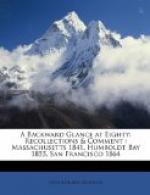And so the hidden harbor that had long inspired legend and tradition, and had been the source of great suffering and loss, was revealed. It was not fed by the Trinity or any other river. The mouth of the Trinity was not navigable; it did not boast a mouth—the Klamath just swallowed it. The Klamath’s far-northern mouth was a poor affair, useless for commercial purposes. But a great empire had been opened and an enormously serviceable harbor had been added to California’s assets. It aided mining and created immense lumber interests.
Strange as it may seem, Humboldt Bay was not discovered at this time. Some years ago a searcher of the archives of far-off St. Petersburg found unquestionable proof that the discovery was made in 1806, and not in 1849-50. Early in the nineteenth century the Russian-American Company was all-powerful and especially active in the fur trade. It engaged an American captain, Jonathan Winship, who commanded an American crew on the ship “Ocean.” The outfit, accompanied by a hundred Aleut Indians, with fifty-two small boats, was sent from Alaska down the California coast in pursuit of seals. They anchored at Trinidad and spread out for the capture of sea-otter. Eighteen miles south they sighted a bay and finally found the obscure entrance. They entered with a boat and then followed with the ship, which anchored nearly opposite the location of Eureka. They found fifteen feet of water on the bar. From the large number of Indians living on its shores, they called it the Bay of the Indians. The entrance they named Resanof. Winship made a detailed sketch of the bay and its surroundings, locating the Indian villages and the small streams that enter the bay. It was sent to St. Petersburg and entered on a Russian map. The Spaniards seem never to have known anything of it, and the Americans evidently considered the incident of no importance.
Humboldt as a community developed slowly. For five years its real resources were neglected.
[Illustration: Humboldt bay—from Russian Atlas the hidden harbor—thrice discovered Winship, 1806. Gregg, 1849. Ottinger, 1850.]
It was merely the shipping point from which the mines of the Trinity and Klamath rivers were supplied by mule trains. Gradually agriculture was developed, and from 1855 lumber was king. It is now a great domain. The county is a little less than three times the size of the state of Rhode Island, and its wealth of resources and its rugged and alluring beauty are still gaining in recognition.




